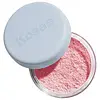What's inside
What's inside
 Key Ingredients
Key Ingredients

 Benefits
Benefits

 Concerns
Concerns

 Ingredients Side-by-side
Ingredients Side-by-side

Silica
AbrasiveVinyldimethicone
Synthetic Fluorphlogopite
Talc
AbrasiveHdi/Trimethylol Hexyllactone Crosspolymer
Methicone
EmollientPhenoxyethanol
PreservativeCaprylyl Glycol
EmollientCI 77492
Cosmetic ColorantTriethoxycaprylylsilane
Lauroyl Lysine
Skin ConditioningCI 15850
Cosmetic ColorantPersea Gratissima Oil
Skin ConditioningSimmondsia Chinensis Seed Oil
EmollientCentella Asiatica Extract
CleansingMacadamia Integrifolia Seed Oil
Skin ConditioningTriticum Vulgare Germ Oil
EmollientBisabolol
MaskingGlycine Soja Oil
EmollientCalendula Officinalis Flower Extract
MaskingZingiber Officinale Root Extract
MaskingTocopherol
AntioxidantSilica, Vinyldimethicone, Synthetic Fluorphlogopite, Talc, Hdi/Trimethylol Hexyllactone Crosspolymer, Methicone, Phenoxyethanol, Caprylyl Glycol, CI 77492, Triethoxycaprylylsilane, Lauroyl Lysine, CI 15850, Persea Gratissima Oil, Simmondsia Chinensis Seed Oil, Centella Asiatica Extract, Macadamia Integrifolia Seed Oil, Triticum Vulgare Germ Oil, Bisabolol, Glycine Soja Oil, Calendula Officinalis Flower Extract, Zingiber Officinale Root Extract, Tocopherol
Mica
Cosmetic ColorantSilica
AbrasiveIsodecyl Neopentanoate
EmollientBambusa Arundinacea Stem Extract
Skin ConditioningBoron Nitride
AbsorbentHydrogenated Vegetable Oil
EmollientC15-19 Alkane
SolventHelianthus Annuus Seed Oil
EmollientTocopherol
AntioxidantCitric Acid
BufferingGlyceryl Undecylenate
EmollientGlyceryl Caprylate
EmollientPentylene Glycol
Skin ConditioningSodium Dehydroacetate
PreservativeCI 19140
Cosmetic ColorantCI 45410
Cosmetic ColorantCI 15850
Cosmetic Colorant
 Reviews
Reviews

Ingredients Explained
These ingredients are found in both products.
Ingredients higher up in an ingredient list are typically present in a larger amount.
Ci 15850 is the pigment color red. It is an azo dye and created synthetically.
Azo dyes need to be thoroughly purified before use. This allows them to be more stable and longer-lasting.
This ingredient is common in foundations, lipsticks, and blushes. This color is described as brown/orangey red.
It has many secondary names such as Red 6 and Red 7. According to a manufacturer, Red 6 usually contains aluminum.
Learn more about CI 15850Silica, also known as silicon dioxide, is a naturally occurring mineral. It is used as a fine, spherical, and porous powder in cosmetics.
Though it has exfoliant properties, the function of silica varies depending on the product.
The unique structure of silica enhances the spreadability and adds smoothness, making it a great texture enhancer.
It is also used as an active carrier, emulsifier, and mattifier due to its ability to absorb excess oil.
In some products, tiny microneedles called spicules are made from silica or hydrolyzed sponge. When you rub them in, they lightly polish away dead skin layers and enhance the penetration of active ingredients.
Learn more about SilicaTocopherol (also known as Vitamin E) is a common antioxidant used to help protect the skin from free-radicals and strengthen the skin barrier. It's also fat soluble - this means our skin is great at absorbing it.
Vitamin E also helps keep your natural skin lipids healthy. Your lipid skin barrier naturally consists of lipids, ceramides, and fatty acids. Vitamin E offers extra protection for your skin’s lipid barrier, keeping your skin healthy and nourished.
Another benefit is a bit of UV protection. Vitamin E helps reduce the damage caused by UVB rays. (It should not replace your sunscreen). Combining it with Vitamin C can decrease sunburned cells and hyperpigmentation after UV exposure.
You might have noticed Vitamin E + C often paired together. This is because it is great at stabilizing Vitamin C. Using the two together helps increase the effectiveness of both ingredients.
There are often claims that Vitamin E can reduce/prevent scarring, but these claims haven't been confirmed by scientific research.
Learn more about Tocopherol